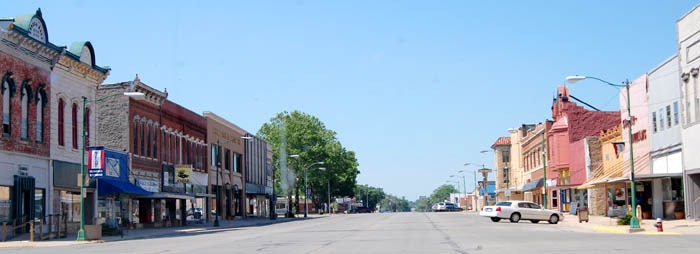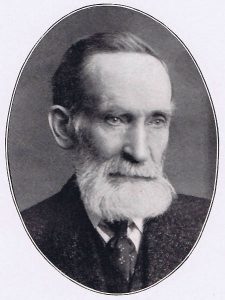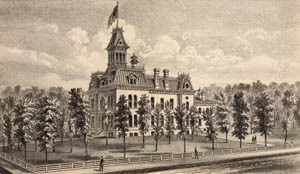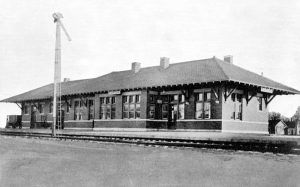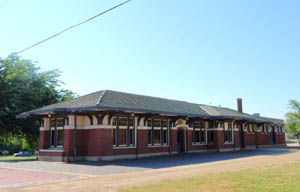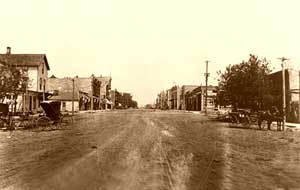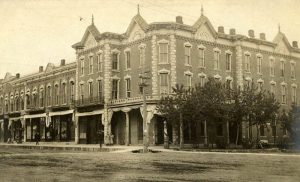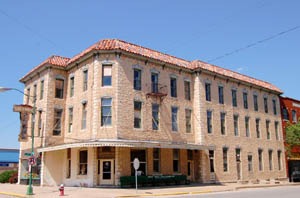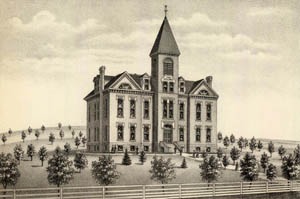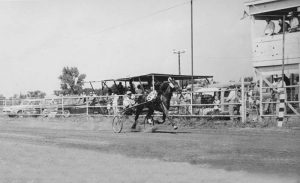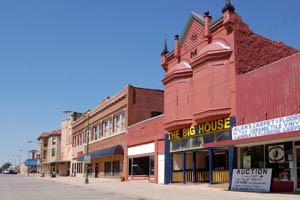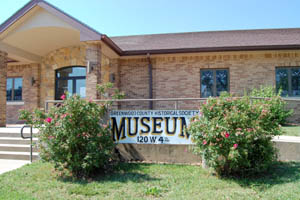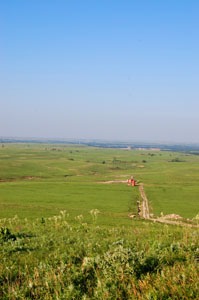Eureka, Kansas, the county seat and largest town in Greenwood County, is located south and a little west of the center of the county on the Fall River. The town was founded by the Eureka Town Site Company in 1857 and named after the Greek expression Eureka, meaning “I have found it.”
The first building erected was a schoolhouse made of short planks hewn from logs and roughly finished. The building also served as a church and a place for public meetings. At this time, the nearest post office was near Burlington, in Osage County, and mail for Eastern friends had to be sent by the chance hand of overland travelers. However, in August 1858, Eureka gained its own post office, with Edwin Tucker as postmaster.
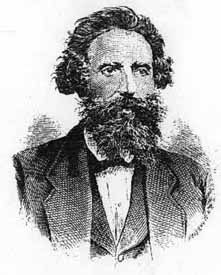
Colonel James Montgomery
At the start of the Civil War, Fort Montgomery was built in the summer of 1861 by local citizens for protection against Indian attacks and Confederate guerrilla forces. It was named in honor of Colonel James Montgomery, a Free-state leader. The fortress was a solidly built large rectangular building with gun hole windows, surrounded by layers of green logs covered with earth up to the level of the gunholes. A small cannon was mounted outside. It was commanded by a local farmer named Leander Bemis but was sometimes occupied by local militia and government scouts. In 1861, when Eureka’s school burned, classes were taught at the fort.
The fort expected a guerilla attack late in the Civil War, and the locals prepared to fight. However, the attack didn’t come. In 1868, regular U.S. troops again occupied the fort, but their stay was brief. Afterward, the post was dismantled and used for firewood. Today, all that is left is a marker on a building in Eureka at First and Oak Streets.
There was no store in Eureka until after the Civil War had ended. Before that time, goods had to be brought from Kansas City or Atchison with ox teams. The first store was a community affair. James Kenner agreed to keep the store, understanding that if it interfered too much with his occupation of farming, he would turn it over to Edwin Tucker at the end of the year. A stock of goods was procured and brought to town, but it was not until early April 1866 that a cabin could be secured large enough to accommodate them. At the end of one year, Judge Kenner turned the stock over to Edwin Tucker, who ran the store for about six months and then sold out to two newcomers, Hitchcock & Farris.
After the war, the wooden schoolhouse was replaced with a stone building. Among the first business and professional men were Dr. Reynolds, the first physician; McCartney, blacksmith, 1866; Judge Lillie, the first lawyer, 1868; Hawkins, the first carpenter, 1867; and Mr. Akers, who was the first landlord of the company hotel. Unfortunately, Dr. Reynolds drowned shortly after he arrived in the Cottonwood River. A few years later, he was succeeded by Dr. Tutton, who settled here in 1868 and remained a few years.
In 1867, Eureka was incorporated. Eureka became the county seat, and the first term of court was held in May 1867 but adjourned without transacting any business. The second meeting was held in May 1868, with a good docket with Judge Watson presiding. In 1868, Eureka also became a city of the third class, with Ira P. Nye as Mayor.
The Eureka Herald was the first newspaper in the county, first published by S. G. Mead in August 1866. It bore the motto, “Be sure you’re right–then go ahead.” The newspaper continues to this day. Other newspapers were also published early on, including the Censorial, which began in September 1875, The Sun in 1878, and the Republican.
The first church in Eureka was the Christian Church, organized on August 20, 1862, by James Kenner, who became its pastor. The next was the Methodist Episcopal Church, organized in March 1868, followed by the First Congregational Church, organized the same year; the First Presbyterian Church in 1872; St. Paul’s Roman Catholic Church in 1881; and the Second Congregational (African-American), also in 1881.
The first bank opened in Greenwood County in the summer of 1870 by Mr. Quackenbush and continued the business until about the first of 1871, when it closed its doors. In the same year, the Eureka Bank was also established in a small frame building opposite the courthouse, where business was transacted until 1879, when it was replaced with a building of brick and stone. The following year, the town also gained the Greenwood County Building and Loan Association, which made loans to erect buildings or make improvements in the county.
The Eureka Mills were built in 1872 by a stock company represented by E. Mahan and cost $18,600. The mill had a capacity of 100 barrels of flour per 24-hour run, and its annual product was about 10,000 barrels.
In 1871, the county submitted a vote of bonds for building a new courthouse. After the vote passed, the building of the three-story structure began with limestone bricks quarried about 1 ½ miles west of town. The building served the county for several years, but, unfortunately, in the second half of the 20th century, it had to be replaced by a more modern building.
In 1873, a stage line operated by James A. McCoy began making runs from Eureka to Emporia and El Dorado, Kansas.
Like most counties containing rich agricultural lands, Greenwood County received overtures from many railway companies, either already operating or projecting lines. The first was from a company projecting a line from Ottawa, and though the proposition was accepted, it was never built. The following proposals from the Fort Scott, Humboldt & Western Railway, and the St. Louis & Kansas Central Railway were voted down in 1871. The following proposal by the Kansas City, Emporia & Southern Railway Company in April 1877 was accepted, and the tracks were built through the county two years later. In 1882, the city also welcomed the St. Louis, Fort Scott & Wichita Railway. Later, these lines were purchased by larger competitors.
In 1882, many of the same influential men who brought the railroad depot to Eureka determined that the quickly growing city needed a hotel. The following year, in October, the Hotel Greenwood, referred to as “The Grand Princess of the Prairie”, was completed for $23,000. It sported 43 boarding rooms and 50 beds. A grand opening ball was held on March 7, 1884, and it was reported:
“Guests began arriving as early as eight o’clock, and at 10:00, when the ceremonies were begun, the elegant and spacious parlors and corridors were thronged with the most brilliant gathering ever seen in Eureka…”
By the early 1900s, the hotel had become a gathering place for cattlemen and had a reputation for being a small livestock exchange. A reporter from the Kansas City Star observed the following about the prosperous cattle industry in the county:
“The lobby of Eureka’s largest hotel is a small livestock exchange. There are the same men with broad-brimmed hats and whips that the visitor sees in Kansas City’s exchange building in the first floor’s corridors. They are always “talking cattle.” Ask for proof of how powerful they are, and the evidence is that when a petition of the Eureka cattlemen for a new railway station went to officials of the Missouri Pacific, work on that station began in less than two weeks. And the Missouri Pacific, it is believed, is not a railroad building new depots everywhere that there is a request for one.”
In Greenwood’s prominent years, it is estimated that over $1,000,000,000 worth of cattle were traded in its lobby, and million-dollar oil deals were completed behind its walls.
Over the years, the hotel changed ownership, was added on to, and refurbished. In 1936, the hotel began serving as a passenger bus station, a role it retained until the 1970s. In 1974, the upper rooms of the Greenwood Hotel were closed, but it remained a headquarters for the local cattlemen. It was sold in 1977 and remained closed for several years. However, in 2002, a preservation society was formed to restore the old hotel. In 2006, it was placed on the State & National Historic Registries. In 2010, renovation of the hotel began. Today, it is open for special events, and retail/commercial spaces are available for rent. It is one of the oldest landmarks in Greenwood County.
In 1884, the Southern Association of Congregational Churches of Kansas organized the Southern Kansas Academy and voted to locate it at Eureka, liberally endow it, and provide a suitable building site. The citizens of the town and county donated a site of 15 acres, and a brick and stone building was erected for $13,000. The two-story building above a basement was a large, light, and well-ventilated structure that sat at the north end of Main Street, commanding a fine view of the city and the surrounding country.
The school was opened in September 1886, with Professor A. J. Burnell as principal. Preparing students to enter the freshman class of a State University or other similar institutions, the purpose of this institution was to establish and maintain a Christian school of a high order. The first class graduated in 1889. By 1892, its enrollment was about 80, with courses of study including classical, scientific, literary, normal, and preparatory. Through the years, Eureka resident Edwin Tucker, one of the school’s founders, was one of its largest benefactors. Shortly after he died in 1911, the school was closed. Many years later, the Greenwood County Hospital would be built on the old site of the academy.
In 1903, Eureka Downs, a horse racing track run by the Greenwood County Fair Association, opened for its first season. It hosted thoroughbred and harness racing until 1942, when the track closed for two years due to the outbreak of World War II. Racing resumed in 1945. In 1962, the Fair Association purchased additional land and built a 440-yard straightaway section to run American Quarter Horse races. The track also held Greyhound racing events on certain race days.
At the track’s peak in the 1970s, purse distribution was over $150,000 for the Futurity race date. Over time, however, interest in the sport declined, and the track struggled to remain profitable. In 1988, the Kansas Racing Commission licensed the Greenwood County Fair Association to oversee para-mutual racing. However, attendance and revenue dropped sharply the following year due to competition from the new Wichita Greyhound Park in Wichita, The Woodlands race track in Kansas City, and larger horse racing venues in surrounding states. By the end of 1989, the track was $330,000 in debt. The track continued to struggle until July 1990, when it filed for bankruptcy and closed. In 1994, it reopened for several years but closed again in 2011, and the facilities were auctioned off.
By 1910, the city had become an important grain, livestock, and produce shipping point, with the Atchison, Topeka & Santa Fe Railroad and the Missouri Pacific Railroad running through the city. At that time, it was described as having several modern improvements, including electric lighting, natural gas for heating and commercial purposes, waterworks, and a fire department. Among the business enterprises were a wagon factory, broom factory, flour mill, four banks, good hotels, and two weekly newspapers. All the leading denominations of churches were represented, and the schools were said to have been unsurpassed in the state. The town boasted a population of 2,333.
In 1916, a significant crude oil strike was made in Greenwood County near the Virgil area. Supplies and equipment were initially brought to the oil field by mule-drawn wagons. During the earliest years of production, the oil was transported via railroad to refineries in El Dorado. By 1920, more oil strikes had been made, and wildcatters and speculators filled the city. At its peak, oil production in the county was more than 4,500 barrels a day.
In 1946, Roger Babson established Utopia College. With World War II recently ended, Babson chose Eureka because of its distance from probable targets in a nuclear war. He intended to place it in an underground college campus that would be safe from nuclear attack. He also believed that central Kansas would have natural resources such as oil, minerals, and grain needed to rebuild following a nuclear war. The two-year college granted certificates rather than diplomas to teach practical business instruction.
Although Utopia College never moved underground or grew very large, the two-year college continued its instruction. In 1955, it became the Midwest Institute of Business Administration. However, due to declining enrollment, the school closed permanently in 1970.
The town’s population peaked in 1960 at 4,055 and has gradually declined.
Today, Eureka is home to about 2,400 people. The small town boasts a new library, aquatic park, restored hotel and train depot, country club, and golf course. It continues to support the oil and gas industries and vast cattle ranches.
©Kathy Alexander/Legends of Kansas, updated June 2025.
Also See:
Sources:
Blackmar, Frank W.; Kansas: A Cyclopedia of State History, Vol I; Standard Publishing Company, Chicago, IL 1912.
Cutler, William G; History of Kansas; A. T. Andreas, Chicago, IL, 1883.
Eureka Chamber of Commerce
Greenwood Hotel
Wikipedia

